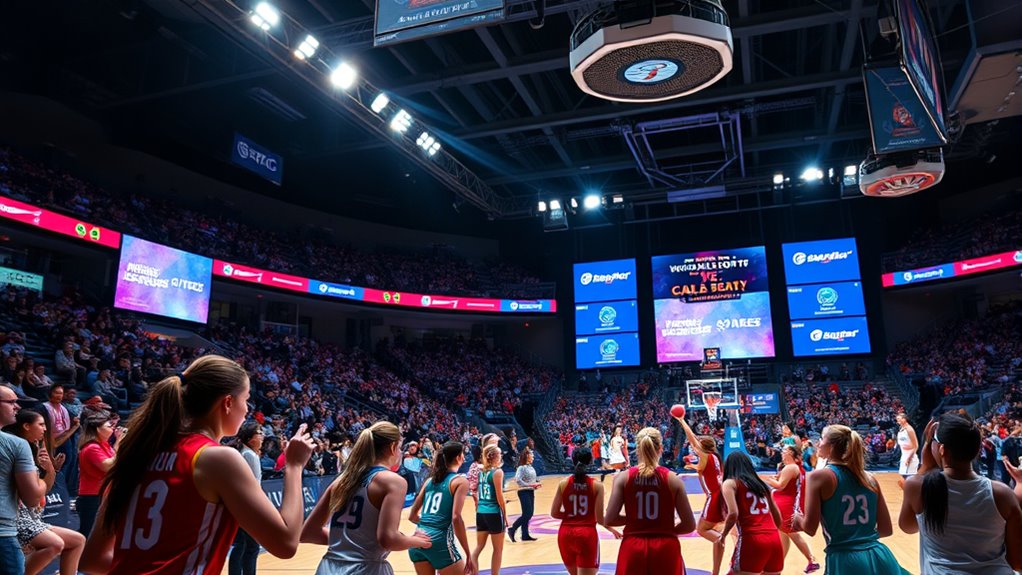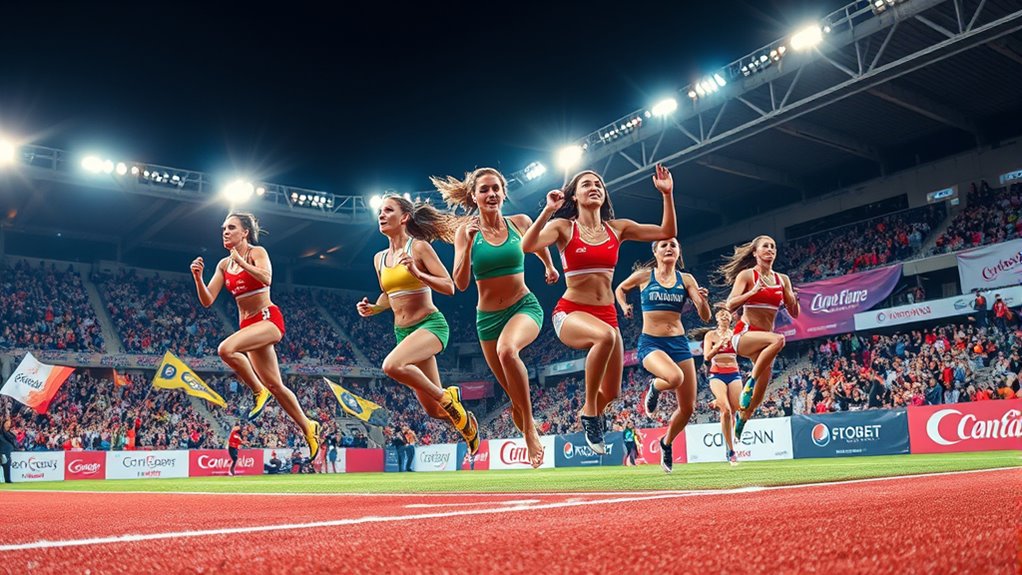Women’s sports sponsorships are outpacing traditional markets because brands see huge growth potential and are enthusiastic to support more inclusive, socially responsible marketing. Increased media coverage boosts visibility, attracting more sponsors and elevating women’s sports to mainstream status. This creates a positive cycle of growth, expanding audiences and opportunities for businesses to connect authentically. If you keep exploring, you’ll discover how this shift is changing the landscape of sports marketing altogether.
Key Takeaways
- Growing media coverage increases visibility, attracting more sponsors and enhancing the commercial value of women’s sports.
- Brands see women’s sports as an opportunity for social impact and authentic marketing, boosting investment.
- The positive cycle of sponsorship, improved quality, and audience growth accelerates industry expansion.
- Female sports audiences are rapidly expanding, especially among youth, providing a larger, loyal consumer base.
- Industry shift towards gender equity and inclusivity makes women’s sports sponsorships more strategic and impactful than traditional markets.

Have you noticed how women’s sports sponsorships are gaining more prominence? It’s clear that brands are recognizing the value in supporting female athletes and teams, not just for social impact but also for business growth. This shift is driven by a growing emphasis on gender equity, both on and off the field. Companies see opportunities to align with a movement that champions fairness and inclusivity, making their sponsorships more meaningful. As a result, more brands are investing in women’s sports, which helps elevate the visibility of female athletes and creates a more level playing field.
Media coverage plays an essential role in this changing landscape. Historically, women’s sports received less airtime and fewer headlines than their male counterparts, limiting exposure and sponsorship opportunities. Now, that’s starting to change. Increased media coverage not only boosts the profile of women’s sports but also attracts more sponsors. When brands see that their target audiences are engaging with women’s sports content—whether through live broadcasts, highlight reels, or social media—they’re more compelled to get involved. This expanded media presence helps to break down stereotypes and shifts public perception, making women’s sports more mainstream and financially viable.
Increased media coverage boosts women’s sports visibility and sponsorship opportunities.
The rise in media coverage feeds into a positive cycle where increased sponsorship leads to better production quality, more thorough coverage, and higher-profile events. As sponsorship dollars pour in, leagues and teams can afford to invest in better facilities, marketing, and athlete development. This, in turn, attracts more viewers and fans, further amplifying the reach of women’s sports. It’s a cycle of momentum that’s steadily outpacing traditional markets, where male sports have long dominated advertising dollars and media attention.
Furthermore, brands now understand that supporting women’s sports isn’t just about social responsibility; it’s a smart business decision. The audience for women’s sports is growing rapidly, especially among younger demographics who value brands that stand for equality and authenticity. By sponsoring women’s sports, companies not only boost their brand image but also tap into a loyal and expanding consumer base. This strategic focus is driving sponsorship deals that are increasingly large and impactful, outpacing many traditional markets.
In essence, the combination of a commitment to gender equity and expanding media coverage is fueling a transformation. Women’s sports sponsorships are no longer peripheral; they’re becoming a central part of sports marketing strategies. This growth isn’t just a trend—it’s a sign that the industry recognizes the importance of equality and the economic potential that comes with it. Additionally, understanding the offensive and defensive strategies involved in sports can help brands better tailor their sponsorship approaches for maximum impact.
Frequently Asked Questions
How Do Sponsorship Deals in Women’S Sports Compare Financially to Men’S Sports?
You’ll find that sponsorship deals in women’s sports are increasingly closing the gender pay gaps, making them more attractive for brands. While they often start smaller, sponsorship diversity is growing, leading to more financial opportunities compared to traditional men’s sports markets. This shift helps brands connect with diverse audiences and boosts overall investment. As a result, women’s sports sponsorships are rapidly gaining ground, offering promising future financial prospects.
What Are the Long-Term Impacts of Increased Women’S Sports Sponsorships?
Think of the rise in women’s sports sponsorships as a ripple effect, transforming the game. You’ll see long-term impacts like cultural shifts that promote equality and inclusivity. As brands build authentic connections, they foster greater loyalty from fans and consumers. This shift challenges traditional markets, encouraging a more diverse and dynamic sports landscape, ultimately leading to sustained growth and a more equitable future for women’s sports.
How Do Sponsorships Influence Female Athlete Visibility and Career Development?
Sponsorships boost media exposure, making female athletes more visible and accessible to fans. This increased visibility strengthens athlete branding, helping you attract more sponsorships and career opportunities. When companies support women’s sports, they elevate athlete profiles, inspiring young athletes and fostering a positive cycle of growth. Your visibility grows as media coverage expands, opening doors for long-term career development, endorsements, and a broader recognition of female athletic talent.
What Role Do Social Media and Digital Platforms Play in Women’S Sports Sponsorship Growth?
Imagine social media and digital platforms as the megaphones amplifying women’s sports stories. They give you direct access to athletes, making their achievements feel personal and inspiring. Platforms like Instagram and TikTok boost visibility, attracting sponsors enthusiastic to connect with engaged audiences. Data shows that digital engagement for women’s sports has tripled in recent years, proving these platforms are essential in driving sponsorship growth and empowering athletes worldwide.
Are There Any Challenges Unique to Marketing Women’S Sports Compared to Men’S?
You’ll find marketing women’s sports faces unique challenges, like overcoming gender bias that can limit visibility and support. Engaging audiences also requires tailored strategies because perceptions of women’s sports differ from men’s. You must work harder to showcase athletes’ stories and achievements, ensuring authentic representation. By addressing these issues, you can foster greater audience engagement and help break down barriers, making women’s sports a more appealing and inclusive sponsorship opportunity.
Conclusion
As you consider the rapid growth of women’s sports sponsorships, it’s clear that this trend challenges traditional markets and expectations. Some argue it’s driven by shifting societal values and increased visibility, while others believe it’s a strategic move by brands seeking authentic connections. The truth likely combines both factors, reflecting a genuine cultural shift and smart marketing. Embracing this change not only benefits women’s sports but also reshapes the future of sponsorships across all markets.










